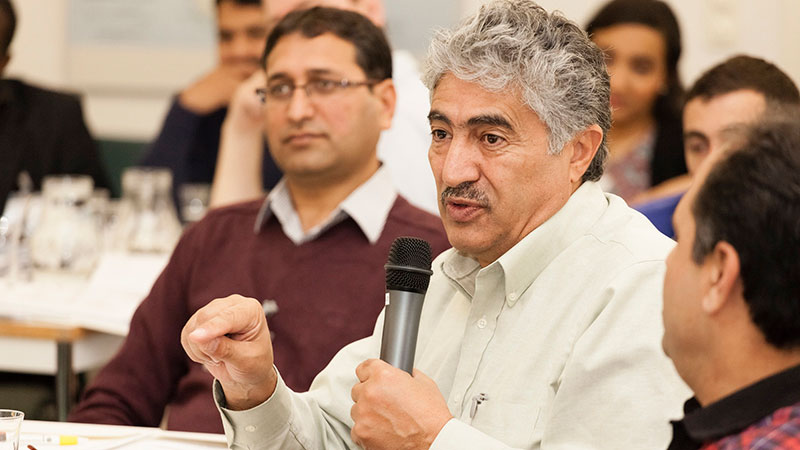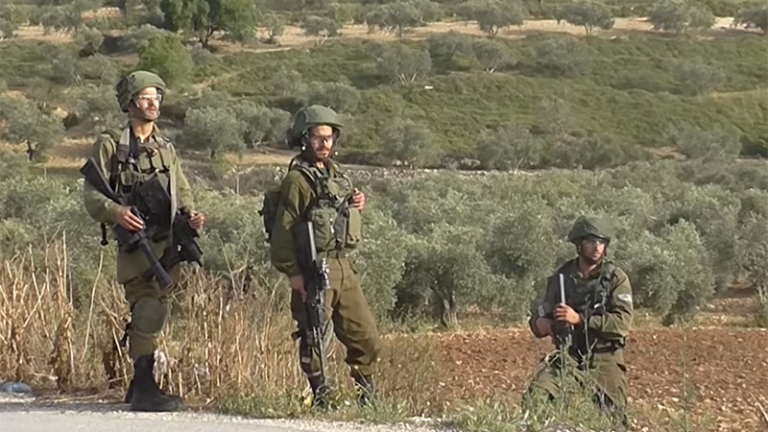
Direct Negotiations
September 22, 2011
Signs of Hope
November 1, 2016
July 2016: This article I wrote over 10 years ago, and published in Sojourners’ magazine. It shows what is wrong with the Oslo Process, and how the peace and justice community got trapped into abandoning their principles and lining up behind Oslo.
Broken Cicterns
Before this summer’s carnage in Gaza, the latest round of Israeli-Palestinian peace talks had already fallen apart. But even if the Oslo approach had “worked,” the result would not have brought about a just peace in the Middle East.
My people have committed two sins: They have abandoned me, the spring of living waters, and have dug for themselves cisterns, broken cisterns, cisterns that hold no water.—Jeremiah 2:13
In the late 1980s and early ’90s, Palestinians rose up against the Israeli occupation of Palestinian territories in what became known as the First Intifada. Instead of acceding to the demands for justice by the “children of the stones,” the response was a process of talks that lead to the signing of the Oslo Accords in 1993.
The “peace process” engaged the leadership of the PLO (Palestine Liberation Organization)—then weak, corrupt, exiled, and with little vision or support—in what turned out to be a worse-than-fruitless effort that led to the perpetuation of the occupation and suffering of the Palestinian people, and which made a just peace even further away.
The process was intriguing to many of us in the peace and justice community, and it successfully co-opted us, as it co-opted the Palestinian leadership, but this process entailed both the abandoning of principled positions and the adoption of the Oslo system, a broken system, that could not possibly deliver what it promised.
First, we were treated to a new language by Israel and the U.S., which seemed at first blush to adopt our own slogans: Where Palestinians were constantly complaining of Israel’s refusal to acknowledge them—its demonization of their leadership, and trying to have Jordan or the Village Leagues or other local collaborators speak on their behalf—the new process brazenly invited the PLO itself and its leader Yasser Arafat to participate as the “sole legitimate representative of the Palestinian people.”
The fact that the PLO was not allowed to speak on behalf of two-thirds of the Palestinian people (the refugees in exile) or for those who were citizens of Israel was not initially clear, and Yasser Arafat was exalted as a leader beyond reproach. His own failures in the area of transparency and his undemocratic actions were politely overlooked, as were the failures of Yitshak Rabin, his Israeli counterpart, since both were viewed as men of peace, and we wanted to give peace a chance by giving them room to maneuver, rather than stubbornly insist on principles.
The slogan of “direct negotiations,” a very legitimate idea, was also turned on its head. The negotiations process neatly side-stepped international law, the United Nations, and European and Arab countries and allowed Israel to negotiate directly with the PLO with no involvement from any third party. In effect, it provided a forum for the wolf and the sheep to work out their culinary relationship with no outside interference.
The continuing human rights abuses and the illegal settlement activities were also downplayed, since these issues were supposedly actively under negotiation, and it was deemed necessary to give both parties an opportunity to work out their differences. All this was done while Palestinians were urged to celebrate and concentrate their efforts on building their “own system” in Area A (the densely populated cities). People of goodwill, both inside and outside the area, were urged to support the peace process and help the moderates engaged in it against the extremists who were trying to derail it.
In the meanwhile, the negotiations lent legitimacy not only to existing settlements and their expansion, but to the creation of a sophisticated structure of two separate systems of life, one for Jews and another for Arabs in the occupied territories, with separate roads, schools, health systems, social security, courts, and police, and not merely different laws and separate living quarters for the two communities.
The slogan of a Palestinian state was also co-opted as the Palestinian National Authority (PNA, also known as the Palestinian Authority) was created, which was given some of the trappings of a state without any of its powers or sovereignty. In fact, the PNA was specifically designed to serve as a subcontractor for the occupation, with the clear mandate to control its own people on behalf of the occupiers, while they were beholden to the Israelis and the donor community for their very salaries. All this was done while Palestinians were urged to celebrate and concentrate their efforts on building their own system in Area A.
How did this happen?
The truth is that these early days were very heady and exhilarating days as we, and I include myself, witnessed the handshake on the lawn of the White House, saw the Nobel Peace Prize given, and heard our very own slogans repeated as official policy of the U.S. State Department. We were no longer “voices crying in the wilderness” or marginalized unrealistic idealists but invited honored guests in the hallways and corridors of power and decision-making. At long last, we were being effective and heeded by the very centers of power we previously criticized and mistrusted.
The price of toning down our principled criticism, accepting some measure of “realism,” and making concessions in order to give peace a chance seemed to be a reasonable position and a small enough price to pay. The alternative seemed to put us in the camp of rejectionists, extremists, and radicals who did not believe in peace at all, and who were bent on hatred, enmity, and undermining anything positive. So we went along and, before we knew it, the trap snapped shut and we were caught.
In fact, as extremists from both sides continued to practice and preach violence and even assassinated Rabin, we became even more invested in the “peace process” and seeking ways to salvage it, jump start it, or help it survive. In other words, the broken cisterns were our own, and we were involved in trying to patch them up.
So how were the cisterns broken? And why could they not deliver the outcome they promised? I believe we need to understand the mechanisms of the peace process to appreciate why the cisterns were fundamentally broken.
First: A process was created (the Oslo Framework) that was both divorced from principles and organs of international law and the international community and that also declared itself to be the one and only proper forum for discussing and resolving the conflict. Any attempt to appeal to international organs, the United Nations, or other bodies was specifically prohibited by the terms of the Oslo process. Going to the United Nations would be considered a violation of the terms as well as the spirit of the process.
Similarly, attempts to engage or involve third parties (or indeed for the Palestinian people to be involved in any anti-occupation activity) would also be viewed as contrary to the peace process. No mechanism was created to enforce compliance with the agreement, so Israel could and did regularly violate its terms (such as allowing free passage between Gaza and the West Bank), but Palestinians were strictly held to their obligations under it, and Israel had a variety of sanctions to penalize them for doing so.
Second: The process accurately reflected the power relationship between the parties and was specifically engineered to grant the powerful party clear advantages, and to maintain the dependence and weakness of the weaker party. Under the terms of the signed agreement (the first of several such agreements), issues of concern to Israel (such as security, control of borders, settlements, etc.) were specifically relegated to its sole authority and control. Issues of concern to Palestinians, however, were relegated, instead, to joint committees where Israel has veto power.
The Palestinian Authority was therefore required on a continuing and even daily basis to submit to the joint committees requests for everything from permits for movement within as well as to and from the territories to supply of water, fuel, and electricity, to imports and exports, to designating radio frequencies for broadcasting—everything! That meant that the Palestinian Authority could not deliver services or perform functions within its purview without prior Israeli approval. Even customs and import duties for West Bank goods were collected by Israel (with 25 percent withheld for “administrative services”) and turned over to the Palestinian Authority only if the PNA remains on good terms with it. When cooperation between Palestinians and Israelis broke down, the PNA was paralyzed.
Third: The Palestinian Territories were divided into non-contiguous parcels labelled A, B, and C, respectively. Areas A (comprising the densely populated cities and towns) were under the control of the PNA; Areas B (mostly villages) were under joint Israeli-Palestinian control, with the PNA having responsibilities in civil matters and Israel in security matters; and finally Areas designated as C (about 62 percent of the West Bank)—containing all the settlements, the Jordan valley, and all the empty land in between—was under full control of Israel and its civil administration.
The theory was that the powers of the PNA would gradually increase both in substance and territory, as more land was transferred from C to B and then to A, ending up with a fully sovereign Palestinian state. Within Areas A and B, the PNA was expected to act in accordance with the agreement, and implicitly in accordance with Israeli desires. Otherwise Palestinians could not move between and among the parcels and would be subjected to a variety of sanctions.
Fourth: Within the areas “ceded” to Palestinian control, the PNA was required to act as subcontractors for Israel and serve its interests, especially in security matters. The PNA was required to control its population and provide continuing security cooperation with the Israeli forces. Where the PNA failed to act sufficiently, Israel permitted its forces frequent incursions and forays into Zones A, whether for the purpose of arresting and detaining individuals as it seemed fit or just for patrolling purposes.
The Palestinians had correctly decided to end armed struggle against the occupation, and to cooperate in preventing attacks against Israel, yet Israel (and sometimes the PNA) viewed this as requiring them to end all forms of struggle as well. PNA police officers are required to prevent Palestinians from moving to points of contact and friction with Israelis for purposes of demonstrating, and when Palestinians acted politically in ways Israel did not like, they were accused of failing in their assigned functions under the agreements.
Fifth: The process was an integral part of Israel’s ideological policy of “Hafrada” (separation). The model of “they are there and we are here” was first readily accepted even by the peace community in Israel and elsewhere as a form of self-determination and neighborly coexistence. When security cooperation between the PNA and Israel broke down with the Second Intifada, which began in 2000, this philosophy was confirmed with the building of the separation wall which confirmed in concrete terms the policy of separation between Arabs in the West Bank and Gaza and Israel.
Each of these elements—all basic ingredients of the Oslo peace process—ran contrary to our notions of justice, reconciliation, and peace. They serve the Israeli goals of the occupation, fragment the Palestinian people, foster discrimination and apartheid, co-opt and shackle their leaders into a subservient role, and legalize and legitimize the continuing occupation, while blocking as illegitimate all avenues of working toward a just solution. A “peace process” built on these principles necessarily would fail to produce justice or peace, and serves only to perpetuate and legitimize the occupation.
Jonathan Kuttab is a leading human rights attorney and peace activist in Israel and Palestine. He is co-founder of the Palestinian Center for the Study of Nonviolence and the Mandela Institute for Political Prisoners.
Quotes:
The “peace process” provided a forum for the wolf and the sheep to work out their culinary relationship with no outside interference.
The negotiations lent legitimacy to the creation of a sophisticated structure of two separate systems of life.
The Palestinian Authority was specifically designed to serve as a subcontractor for the occupation.






